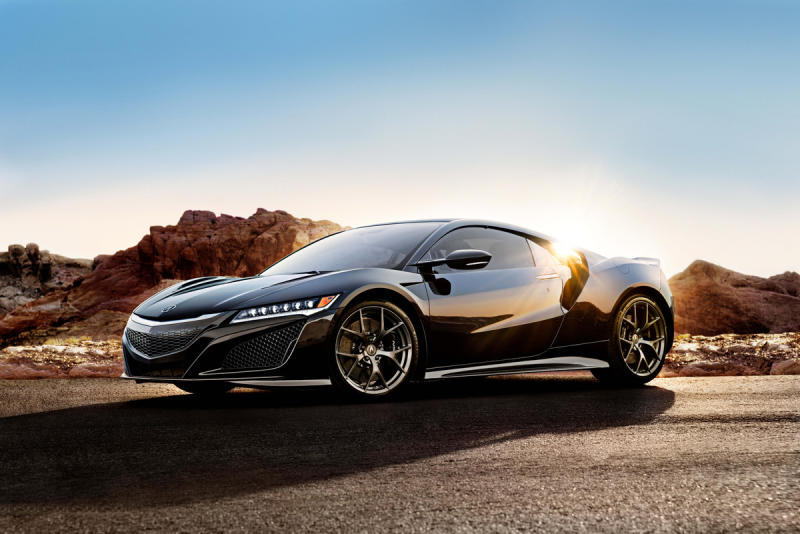- Joined
- 16 November 2009
- Messages
- 145
What Is It? 2017 Acura NSX, the Japanese manufacturer’s long-awaited mid-engine 2-seat flagship.
Starting Price: $150,000 (Estimated)
Competitors: Audi R8 V10, Mercedes-AMG GT-S, Porsche 911 Turbo
Alternatives: McLaren 570S, Lamborghini Huracan
Pros: Digital drivetrain works seamlessly and cohesively; even quicker than it feels; comfy enough for daily use.
Cons: Could use more fierceness and feedback; hefty (and well out of supercar range) at 3,802 pounds; that nagging feeling that nice supercars never finish first.
Would I Buy It With My Own Money? Not quite yet, though this might be more my speed in a couple decades when I’ve had it with hardcore sports cars.
Starting Price: $150,000 (Estimated)
Competitors: Audi R8 V10, Mercedes-AMG GT-S, Porsche 911 Turbo
Alternatives: McLaren 570S, Lamborghini Huracan
Pros: Digital drivetrain works seamlessly and cohesively; even quicker than it feels; comfy enough for daily use.
Cons: Could use more fierceness and feedback; hefty (and well out of supercar range) at 3,802 pounds; that nagging feeling that nice supercars never finish first.
Would I Buy It With My Own Money? Not quite yet, though this might be more my speed in a couple decades when I’ve had it with hardcore sports cars.

The year was 1990 and the supercar future looked bright. While feisty exotics like Ferraris and Lamborghinis ruled the road, a new contender from Japan threatened to turn the supercar microcosm on its ear with fresh styling, an approachable price, and surprising everyday usability. That outsider was the 1st generation Acura NSX, and its finely tuned approach delivered a stylish value proposition that was nothing short of revolutionary in its day.
The mid-engine contender eventually retired after a 15-year reign, resurfacing like a phoenix in 2015 as the all-new 2017 Acura NSX. During its 1st go, the NSX challenged a tiny coterie of 6-figure cars that barely crested the 300 horsepower mark. Nowadays, the upper end of the market is led by near-1,000 horsepower hypercars, while back on planet Earth, many 500-horsepower beasts can be had for under $100,000.
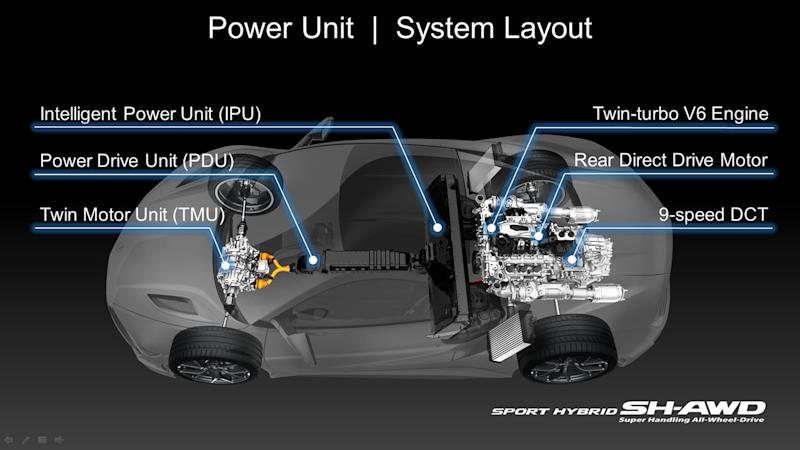
How did Acura challenge the modern day supercar conundrum? For starters, they clad their new flagship with an arsenal of mil-spec technological hardware. The car begins from a transversely mounted, turbocharged 3.5-liter V-6 (an engine shared by no other Honda product), married to an electric motor at the crankshaft, all of which drives the rear wheels. Up front, twin electric motors fed by a lithium-ion battery pack spin the front wheels. Togehter, the system makes 573 hp, with 500 of those equines coming from the twin-turbo V6, while cumulative torque totals 405 lb-ft.
Below the surface, the NSX grows complex fast. Take cooling; there’s no fewer than 10 heat exchangers from 7 major heat sources ,including the internal combustion engine, their turbochargers, the 9-speed transmission and the battery and processors. Stopping duties are performed by carbon fiber brakes, and all 4 corners of the car pitch in to help it around corners: while the rear motor can brake torque, the front motors can push or pull on either side to help tuck the car in and tug it through a turn.
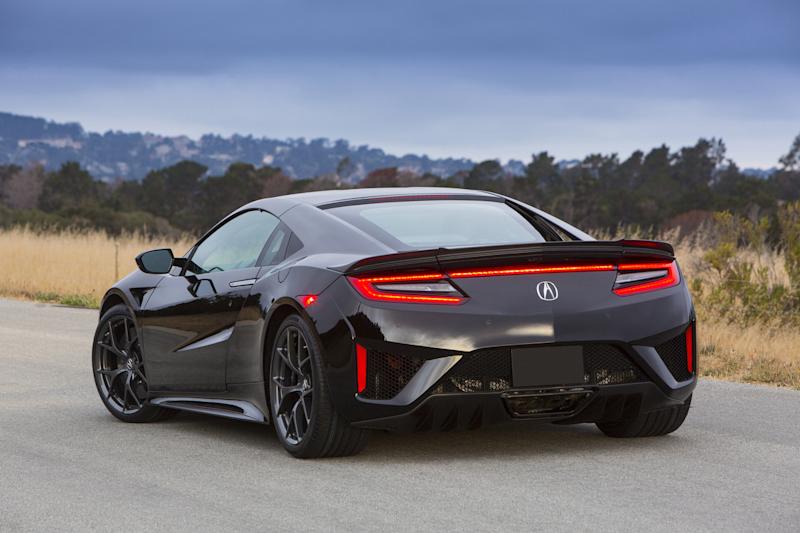
And then there’s the functional challenge of packaging all of those elements, many of which must work together cohesively to make the NSX feel, as Honda engineers call it, a “human-centric ergonomically enhanced design theme.” Among the countless tricks up their sleeve is an A-pillar that’s been “3D bent and quenched”— that is, heated, bent, and quickly cooled with jets of water, enabling narrower construction and better outward visibility. I could go on about the NSX’s novel engineering details and ambitious goals, but all this leads to the same question: How does it drive?
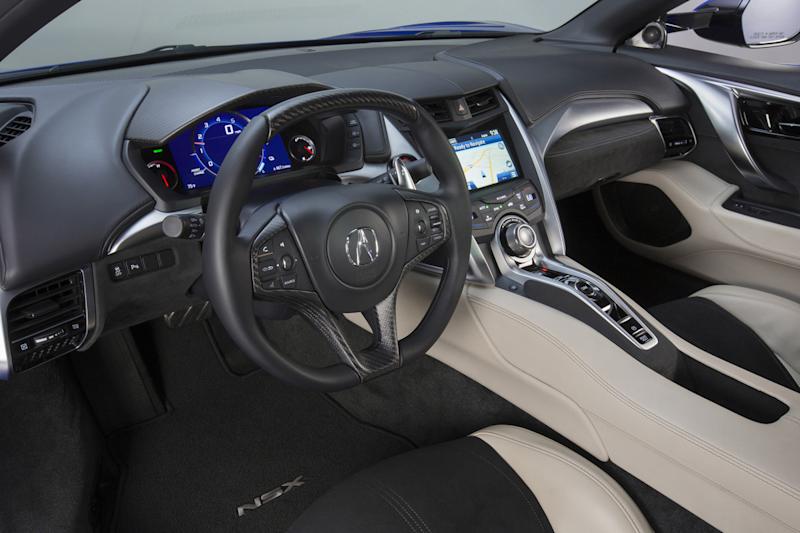
Climb inside the cockpit and the NSX feels every bit an Acura—natural, comfortable, and smartly ergonomic, with excellent outward visibility and front wheel humps positioned for easy apex placement. Though some clever surfacing and contouring lends a sense of flow to the cabin, there’s nothing terribly groundbreaking here; the space seems to dissolve around you, enabling the driver to focus on the comfortably squared-off steering wheel. The NSX fires up with a healthy cough from the twin-turbo V-6, and the dual-clutch switches smoothly into gear, while a large Dynamic Mode dial toggles through 4 settings—Quiet, Sport, Sport+, and Track. The modes control everything from throttle mapping and regenerative power patterns to brake pedal feel and suspension damping. For some perspective on the degrees of variability at play, there’s a 25-decibel difference between Quiet and Track—to steal from a certain ‘80s song, a whisper to a scream.
Though the NSX accelerates with eerie smoothness, it is also wickedly quick off the line, dispatching quick revs to its 7,500-RPM ceiling before the transmission seamlessly summons the next gear. Though it feels surprisingly undramatic, there’s a lot going on as the NSX hustles itself to speed: electric motors are handling the low end of the power delivery until the turbochargers kick in, at which point the EV propulsion is tapered off in exchange for good old fashioned internal combustion. Perform the launch control sequence, an easy 2-pedal sequence in Track mode, and the blast off is, once again, drama (and almost completely tire squeal) free. The result, however, is staggeringly quick; though Acura hasn’t disclosed an official 0 to 60 mph time, they do hint the NSX beats the Porsche 911 Turbo’s 3.0 second figure by a 10th of a click. Hot damn, Acura; who would’ve guessed you’re such a speed freak?
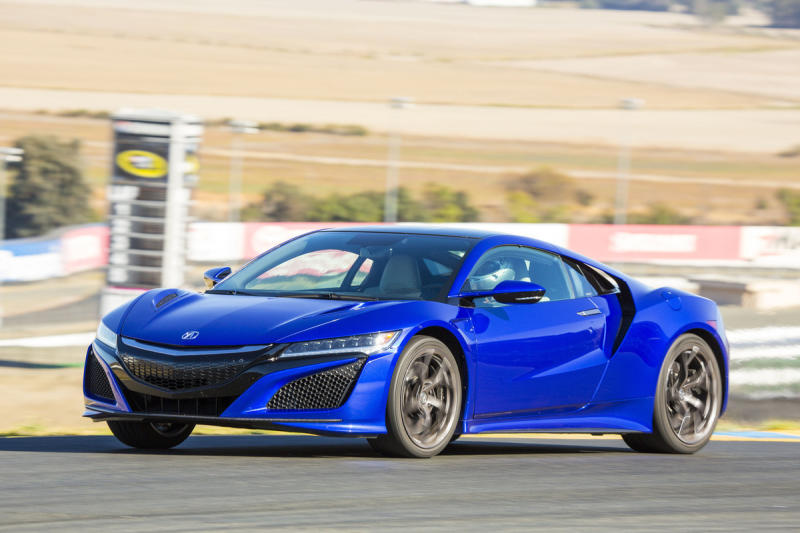
Depending on which mode you choose to tackle the track with, you’ll experience varying degrees of intervention and tightness. Predictably, there’s a bit of safety-inducing understeer in milder settings and more satisfaction to be found in Track, where the front tires seem to find the apex with not-so-predictable ease. You can credit the electronically managed torque vectoring magic for the NSX’s ability to turn and tuck-in when the throttle is lifted; after all, these 3,800 pounds aren’t going to turn themselves. Though it’s capable of impressive athletics for its curb weight, the NSX does so with surprisingly little kickback. There isn’t a whole lot of information funneled through the steering wheel, and the powertrain’s lack of peakiness makes for an undramatic ride. Even brake pedal feel is modulated to within an inch of its life; rather than a physical connection to the hydraulic reservoir, the NSX’s binders use drive-by-wire technology with a force feedback system that alters how the pedal responds based on drive mode and brake rotor temperature.
Though the automatic transmission is virtually flawless in the Track setting, telepathically holding gears and downshifting when necessary, tapping the paddle shifter unfortunately does not summon an upshift. Also, turning all systems off doesn’t completely remove the digital nannies; when I abruptly lifted off the throttle, the system kicked in to save my bacon. Despite the danger of driving without electronic aids, I would personally prefer a more permissive track mode and that rarest of touches, a real “off” switch for the babysitter.
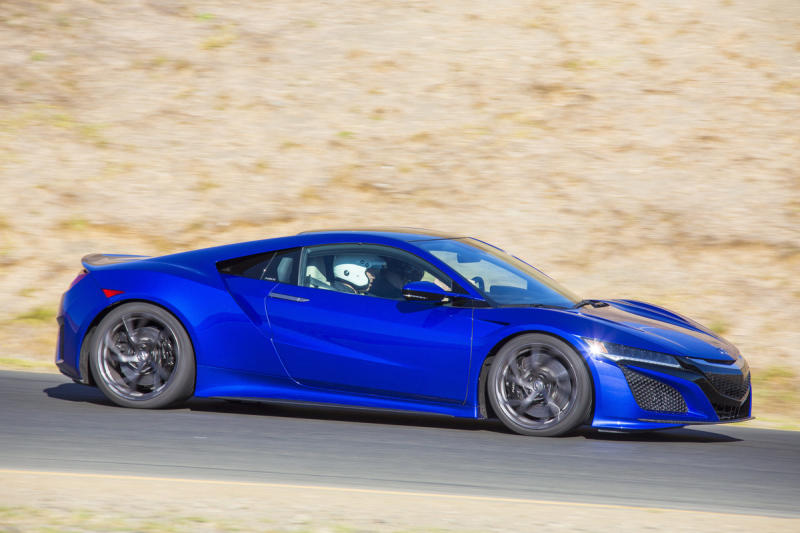
Despite the near invisibility of all the electronic systems, the 2 tire choices offer significantly different levels of grip: the standard 4-season Continentals grease up and give up the ghost too early, leaving you cautious and leery on the track. The Michelin Pilot Sport Cup 2s, on the other hand, feel grippy and confidence inspiring, delivering dramatically more tenacious road holding.
A 2nd day of street driving on the winding roads between Calistoga and San Francisco put the NSX’s capabilities into a far more comprehensible, real world context. On the high-speed sweepers connecting California’s wine country to the Pacific, the NSX felt hunkered down and capable, rolling with the road’s punches and accelerating and braking with aplomb. Under these conditions the Acura comes across as more comfortable; not that it can’t hold its own on the track, it simply seems more in its element on the road. Despite the ducts, vents and flying buttresses, the NSX presents itself as a grand tourer rather than a wannabe racer, choosing to cosset its driver rather than transmit tangibles like road texture and bump steer to the passenger compartment.
Purists can (and most certainly will) crave more feedback from Acura’s new flagship. But until the inevitable R-Spec track special comes along, the NSX’s disposition will be dialed in for refinement, not raucousness. With an estimated starting price of around $150,000, the new NSX faces the likes of the Mercedes-AMG GT-S Coupe ($130,825), Porsche 911 Turbo ($151,100), and Audi R8 V10 ($153,900).
Unlike the 1st-generation’s underdog status, the new NSX’s position in the supercar world is a difficult 1 to gauge, given how entirely different it is. If you crave the saucy excitement of a track-focused superstar, you might be inclined to think of the NSX as a too-smooth, too-nice way of getting from A to B.
But if you’re the happy-go-lucky type, you might think of the NSX as a sort of poor man’s Porsche 918 Spyder, a technical tour de force that delivers a good chunk of the performance for a fraction of the cost. It’s too early to tell which side of history this Acura NSX will fall on, but the reincarnation offers a polished and refined take on the age-old supercar formula.


